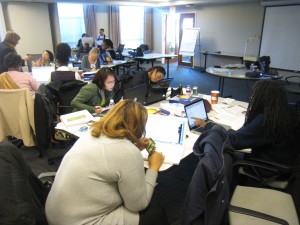Real Data = Real Fun in Census at School Program

A group of middle- and high-school teachers from Washington, DC, participated in the Census at School pilot program. The teachers met for a series of daylong training sessions on implementing the program in their classroom and received instruction in data analysis and statistics. ASA staff will observe the teachers presenting the material in their classrooms and assist where needed.
The American Statistical Association and Population Association of America are bringing the Census at School program to the United States beginning this summer. This international program began in the United Kingdom in 2000 to promote statistical literacy in schoolchildren by using real data. The program is now fully operative in the UK, New Zealand, Australia, Canada, South Africa, Ireland, and Japan. With the decennial census being conducted this year, the U.S. Census at School program will build awareness as students learn how it provides essential information for planning education, health, transportation, and many other services.
How It Works
Under the direction of their teachers, students in grades 4–12 anonymously complete an online questionnaire, thus submitting the data to a national database. The questions ask about such things as the length of their right foot, height, favorite subject in school, and how long it takes them to get to school. Thirteen questions are common to every country participating in Census at School, but each country adds its own questions specific to the interests of its children. Periodically the national data from the 13 common questions goes to an international database maintained in the UK.
To teach measurement, data analysis, and statistics, teachers in all participating countries not only can extract the Census at School data submitted by their own students but also obtain a random sample of data from other students—either students from their own country or from all participating countries. Students can engage in statistical problemsolving by formulating questions of interest that can be answered with the data, collecting and selecting the appropriate data, analyzing the data, and making appropriate conclusions in context. The statistical problemsolving process across different levels is described in the Guidelines for Assessment and Instruction in Statistics Education (GAISE) Report: A Pre-K–12 Curriculum Framework.
The Origin of the U.S. Census at School
The genesis for the idea of a U.S. Census at School program began at a workshop at UCLA in 2008 organized by Juana Sanchez. At this workshop, participants developed an understanding of each country’s program and experiences in creating, promoting, and maintaining Census at School. In 2009 a membership initiative was submitted to the ASA Board of Directors to develop a Census at School pilot project for the United States. The ASA’s Committee on International Relations in Statistics submitted the initiative, with strong backing from ASA members Cynthia Clark and Katherine Wallman. The ASA Board of Directors enthusiastically decided to fund it. The Population Association of America gave additional funding; PAA is partnering with ASA on the project through its Committee on Population Statistics, chaired by Linda Gage.
This winter, a group of middle- and high-school teachers from Washington, DC, participated in the pilot program. The teachers met for a series of full-day training sessions on Saturdays at the ASA office. There, ASA Director of Education Martha Aliaga and K–16 Education Manager Rebecca Nichols taught the teachers how to implement the Census at School program in their classroom and gave them instruction in data analysis and statistics. ASA staff will observe the teachers presenting the material to their children in the classroom and assist where needed.
The material developed from the pilot project will be available when the ASA launches Census at School nationally in early summer. The web site will include an online questionnaire unique to the United States, a random data sampler to extract data from questionnaires submitted by students from across the country, and a link to the international data sampler.
The site will also house tools for teachers to use with Census at School in their classroom. One such tool is a webinar presented by William Finzer, leader of the Fathom Dynamic Data Software development team, titled “Exploring Census at School Data from Around the World with Fathom.” Many lesson plans and other resources are already available on the Census at School web sites of each participating country, linked from the international Census at School site here.
UPDATE: The Census at School Program is now online www.amstat.org/censusatschool
Getting Involved
The ASA is looking for champions to expand the Census at School program when it goes national. Teachers and users and producers of statistics at all levels are encouraged to get involved, both to promote the good practice of statistics in schools and to encourage more students to eventually join the statistics profession. This is a wonderful opportunity for ASA chapters to perform outreach in their communities. For more information on how you can get involved, email Martha Aliaga at martha@amstat.org.


















We are very much interested to involve in ” census at school programme” to spread the literacy about statistics. in our school
V.Muralidharan
CEO & Correspondent
Veera Savarkar Netaji MatriculationSchool
19 chinnasamy street, Agaram Chennai, tamilnadu India
email:vsnms99@yahoo.co.uk
mobile: 09444466414